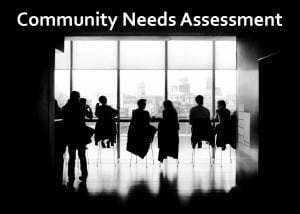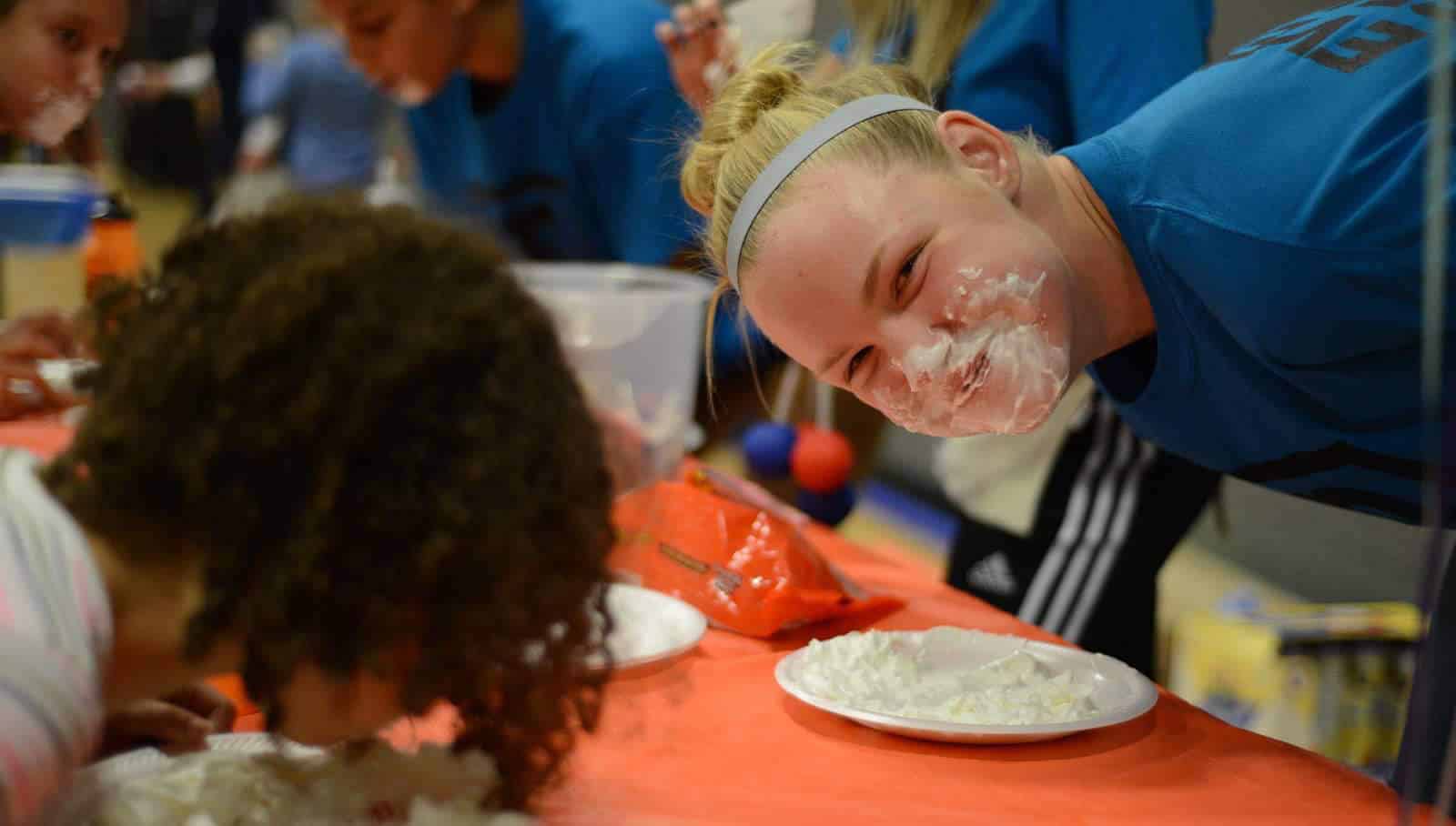Outreach events are great opportunities for establishing name recognition and starting conversations with people in the community. You need to know 1) what your community needs most, 2) what types of events you can effectively deliver with the resources you have to support those needs and 3) the ability to plan and execute events that Honor God and serve people. All this while recognizing the name of your new church is on the line. No pressure!
1. Community Needs Assessment
To begin with, you will need to determine the needs of the community that you are serving. The best approach is to develop a survey for the community and gain insight into the greatest strengths and needs of the community.
The community needs survey should be limited to what can fit on one page. Take a look at our sample Community Needs Survey to get you started. The questions asked will largely influence the results of the survey. Keep the questions broad in nature, provide lots of multiple choice options and allow room for people to make comments. For example, rather than asking a specific question such as, “Do you think this community needs more recreational facilities” ask, “The greatest areas in which our community needs to improve are…” fill in the blank with enough room to write some good answers. If you provide options, allow people to choose multiple answers.

The larger the population of the community, the more surveys you will want to receive to get a good sampling. As you collect the surveys you will begin to see trends emerging as to what the greatest strengths and weaknesses of the community are.
In the sample survey, you will notice that a gift was given away for those who participated. This provides incentive for people to fill out the survey. It also gives you a reason to have additional contact with them through email. One strategy is to use the survey as a means to collect emails for a community database. Then when community service initiatives are done by the church, those who participated in the survey can be invited to serve.
Take a few minutes and read Aubrey Malphurs, 14 Ways to Better Understand Your Community.
Task: Write Community Needs Survey
2. Types of Outreach Events
Outreach events take on many shapes and sizes. The list of possible events is far larger than the actual number that can be conducted. It is important to prioritize the events and identify a strategy that will provide the greatest impact for the limited resources available. It starts with identifying possible events and setting an expectation for how many events you will do. Develop three different lists: 1) events, 2) classes/seminars and 3) service projects. We recommend one or two events per month for each of the six months prior to launch. Some events will target specific neighborhoods while others target entire towns.
Events. Consider at least 3 different types of events:
- Local Neighborhood Events – These events are very simple and can be done with minimal planning and cost (less than $200 each). They will usually impact 50 or less people at a time. For example, a backyard BBQ is a very easy event that every staff member and launch team member should be willing to plan and host. These events provide the opportunity for very personal invitations to friends, neighbors, co-workers, etc. These are small, more intimate events that are easy to plan and should be done locally by each staff member and launch team member.
- Community-Wide Events – These events require more planning or cost (up to $1000) and will likely impact 25-250 people. For example, a community concert hosted at a local park should attract over 100 people with minimal planning and cost (especially if the church band plays). Another example is a parenting seminar on a Saturday morning featuring a special speaker and hosted in a local day care facility. Marketing/promoting these events is more extensive than for neighborhood events and includes flyers, signs, newsletter ads, invitations sent home with kids, etc.
- Regional Events – These events are very large events which have the ability to impact hundreds or even thousands of people. These events require a great deal of planning and budgeting, probably well over the $1000 community event described above. For example, a city wide carnival featuring free games, food, pony rides, clowns/mascots, face-painting, and multiple inflatable rides/amusements. These events receive maximum publicity and marketing including flyers, signs, newspaper ads, newsletter ads, direct mail, radio or other mass means (free public service announcements), etc. The best regional events involve partnering with local civic and community organizations including elected politicians.
Classes/Seminars. These typically target specific community-felt needs within the target demographic and can target large or small groups of people. Examples include:
- Parenting seminar (lead by a local school teacher who is a Christian in cooperation with [Church Name])
- Newcomers Guide to the Community (practical seminar to get new people in the community familiar with the services and features of the community)
- Marriage workshop
- Estate planning workshop
- Personal finances/budgeting workshop
- Time management workshop
- College Preparation for Parents Seminar (getting ready for the college years)
- Basic computer skills
- Job interview and resume skills
- Basic landscaping seminar
Service Projects. Typically smaller scale and low cost, service projects are aimed at localized groups of people. The Random Acts of Kindness Institute maintains one of the best free lists of community service ideas. Browse all, most recent, most popular or search ideas at https://www.randomactsofkindness.org/kindness-ideas. Service opportunities are almost endless and include:
- adopt a highway for cleanup
- volunteer service at local schools
- car wash
- pumping gas and car window washing
- carrying groceries to cars
- Giving away bottled water to commuters
- Giving away stamps at the post office
- Visiting people in nursing homes
- Taking fresh baked goods to local police and fireman
- Handing out snacks or hot chocolate to people standing in line at the Department of Motor Vehicles
Service projects take very little planning and very little money. Each small group could be challenged to make service opportunities a regular part of their focus. Imagine groups that do a weekly service project.
Outreach vs Marketing Strategy
An outreach strategy and a marketing strategy are closely linked. Each outreach event is an opportunity for marketing. In most cases, a new church can get at least 3-5 positive name touches in the local community where the event is being conducted (e.g. flyers, signs, newsletters, invitations, etc.). An outreach strategy should be closely coordinated with the new church’s marketing strategy.
DO NOT RELY ON MARKETING FOR NAME RECOGNITION.
One of the biggest mistakes that new churches make is not aggressively using outreach events to establish name recognition in the community. Too many church planters rely on marketing to establish name recognition. Outreach events are far more effective at branding when used in conjunction with marketing. Ask this simply question:
how will we establish broad name recognition in the community BEFORE our pre-launch direct mail campaign?
3. Planning and Execution
Basics:
- Set Expectations. Your success is directly related to your ability to plan and set expectations. You should schedule events 3 to 6 months before the event date. Churches that proactively plan events find that they can effectively have 5 to 10 (or more) events, twice the number of those who fail to plan. The result: Effectively running events in the community creates positive name recognition.
- Book Your Band. People love music! Outreach events provide great venues for ‘booking’ your worship band in the community. Get people out to events and then get them asking ‘what kind of church does an event like this and has a band like this? My parents church did not have music like this!’
- Build Partnerships. Outreach events provide great opportunities for partnering with other community organizations. Consider co-sponsoring an event or leading portion of a well-known event where you have indigenous expertise such as taking the lead responsibility for children’s games and programming at large annual community events. There are many possibilities if you simply think innovatively and look for opportunities.
Milestone: Serve the Community
Prioritize and Filter Your List
Developing a written plan forces the discipline of looking for innovative ways to get into the community. Since the list of possible outreach events is endless, you need to prioritize and filter through the list and decide what events to actually accomplish.
Here are a few considerations in developing your filter:
- Understand your target demographic and their felt needs (from #1 above). For example, if your target is young families with children, Bingo nights is probably not the right answer.
- Know what other churches and organizations are already doing (establishing a niche). Don’t try to duplicate what is already being done well.
- Be intentional about the Brand/Reputation you are trying to establish. You will become known to your community as the [FILL IN THE BLANK] church. Outreach events will shape how people brand the church. You may be known as a fun church, a legalistic church, a service oriented church, or something else; but you will have a reputation. Use outreach events to build that reputation.
- Apply a Cost-Benefit Analysis. Put on our CEO hat and look for those events that provide the biggest impact for the fewest resources (both time and money). Be a shrewd manager. You can’t do everything! You might be able to do 10 neighborhood events or one regional event, but you probably can’t do both. While you might get 10 times as many people and name recognition with a regional event as you will with a local neighborhood event, that may or may not be the best thing for your church.
We encourage you to plan a balanced mix of these different size events. For example, in each of the three months prior to your launch date, have a community event and plan one large regional event the weekend before the grand opening Sunday. In addition to these community and regional events, consider challenging your launch team to each take ownership for local neighborhood events.
Task: Select and Schedule Outreach Events
The outcome of 1-4 above is a filter through which you decide what events to accomplish during the prenatal phase–before your church is officially launched.
Most church planters get to opening day and wish they had done more outreach events.
Conclusion
Things that get measured get done so have a plan with real goals. After the event is done, meet with your team and evaluate how you did then set (or reset) your goals for the next event. Learn from your success and miscues. Remember that church name recognition in the community is strongly dependent on the number of outreach and service events you conduct in the six months prior to launch. Set demanding expectations for the number of events you will do, stretch yourself or you will end up looking back and wishing you had done more outreach events. As mentioned earlier, we strongly recommend you hold one or two major events in each of the four months prior to launch. This will result in six major events leading up to your launch day — consistent with the marketing philosophy of ‘six to stick’. Set the expectation for every staff person or every family on the launch team to host at least one of these events.
